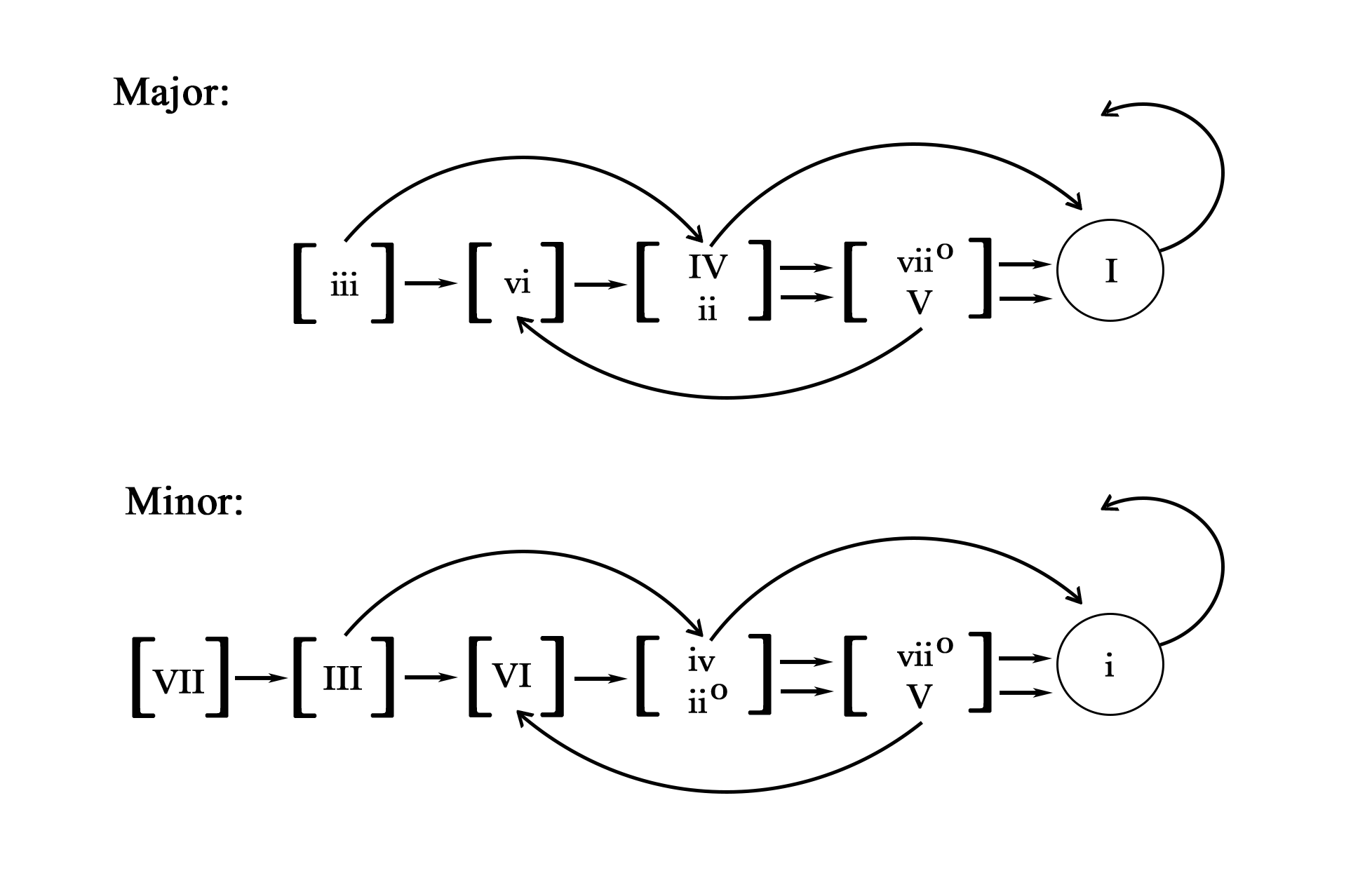11.1 Introduction to Harmonizing a Melody: Tutorial
Harmonizing a Melody
The ability to harmonize a melody is a useful skill. It allows you to take any melody from any piece of music and create arrangements or compare different versions with different chord progressions. When we harmonize a melody we combine our knowledge of functional harmony, phrases, cadences, harmonic rhythm, chords and chord inversions, and part writing.
Things to Consider Before Choosing Chords in a Progression
Functional harmony and types of motion between chords
- Review the functional harmony chart so that you can make good decisions about what types of chords make sense in a progression. For more information on functional harmony, see chapter 6.1.

- Review the types of motion between chords:
- Progression (P): forward motion on the chart by 1 category
- Tonic (T): motion from tonic to any other chord
- Retrogression (R): moving backwards on the chart either by one or more categories
- Similar Motion/Repetition (S): motion within a category
- Elision (E): forward motion on the chart, skipping one or more categories
Cadences, phrases, harmonic rhythm, and melodic form
- Understand melodic form, phrases, harmonic rhythm, and cadences in order to determine the phrases in a melody, the chords used to support the phrase motion, harmonic rhythm, and cadences. Make good to consider relative cadence strength in each phrase in order to choose a progression that makes sense.
- Melodic form and phrases: melodic form describes the relationship of each phrase in the overall structure of the melody.
- Phrases (often 4 bars in length) end with a cadence.
- Phrases can be independent or combine to form periods.
- Sentence form is a common type of melodic form used with phrases and periods.
- For review on melodic form and phrases, see chapter 8.1.
- Harmonic rhythm
- Helps define the meter.
- Often speeds up or slows down at cadence points.
- Often use a new chord for every note in the melody.
- Avoid holding the same chord over a bar line unless the harmonic rhythm is very slow. It creates stagnant feel to the harmonic motion.
- For review on harmonic rhythm, see chapter 6.3.
- Cadence possibilities:
- Final cadence: PAC
- Used as the final cadence
- Harmonic pattern is most often Predominant-Dominant-Tonic
- Dominant used is most often V or V7
- vii˚ is not used because it is too weak for a final cadence
- Cadences within the piece:
- Usually IAC instead of PAC
- vii˚-I (and with inversions) is possible within the phrase
- V-I is (and with inversions) possible within the phrase
- Half: not used as the final cadence, V7 is too strong to use at a half cadence
- DC: not used as the final cadence
- PC: not used as often as the other cadences
- Usually IAC instead of PAC
- For a review on cadences, see chapter 6.2.
- Final cadence: PAC
Type of motion between chords
- Progression, Repetition, and Tonic motion are used most often because they create the smoothest part writing when connecting chords.
Chords and chord inversions
- Most pieces begin and end with tonic, first to establish the key, then to bring the music home.
- Avoid using iii or vi. They are not used are often as the other chords.
- Do not use diminished chords in root position.
- ii does not go to I
- Do not use I∆7 as a substitute for tonic.
- V is always easier to part write with than vii˚.
- Use V7 in root position at cadences, and V7 in inversion within the phrase.
- The dominant and leading tone seventh chords resolve in specific ways, and therefore need to resolve to specific chords, so the melody can either support their use or prohibit their use.
- When possible, inversions should be used in order to create a smooth bass line.
- Second inversion chords must be one of the 4 types in order to be used in a progression, and the chord choices must support their part writing.
- When using seventh chords, if the chordal seventh is in the soprano, it must resolve down by step in the next chord in order to support the use of a seventh chord.
Part Writing Guidelines
- Doubling
- Root position major and minor chords: double the root
- Diminished chords: double the 3rd
- First inversion triads: double anything except tendency tones like the leading tone
- Second inversion triads: double the bass
- Connecting chords
- Choose common tones when possible.
- Move upper voices in contrary motion with the bass when common tones are not possible.
- Resolve the leading tone whenever possible.
- Make sure each chord is spelled correctly, including necessary accidentals.
- Always check for part writing errors.
Steps for Harmonizing a Melody
This is the general list of steps for harmonizing a melody. The list will become more specific as we explore root position chords, chords in inversions, seventh chords, and non-chord tones.
- Identify the key.
- Write down the chords contained in the key in root position.
- Write in the scale degrees in the soprano voice.
- List chord possibilities under each note in the soprano.
- Identify the melodic phrase structure/cadence points and determine harmonic rhythm.
- Eliminate any chords that cannot be used (either from motion in the soprano, connections between chords, or from choices made in phrasing/harmonic rhythm/cadences).
- Choose a progression (if using inversions, choose chords that create a smooth bass line).
- Write in the bass voice and check for it for errors against the soprano voice before writing the inner voices.
- Part-write the inner voices (make good choices in connecting chords melodically). Check your answers for errors.
Proceed to the theory exercises for guided examples for harmonizing a melody.

